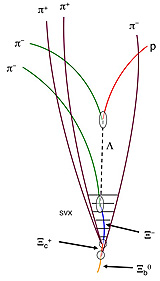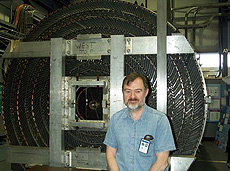CDF finalizes its Ωb analysis
 |
| An illustration of the final state used in the reconstruction of the Ξb0 baryon.
The data was collected by imposing requirements on the tracks in magenta. |
In addition to the wide program of top quark studies performed at hadron colliders, scientists have obtained many results on the physics of particles containing bottom quarks, also known as b quarks, at these machines over the years.
Baryons are particles with three quarks, similar to protons and neutrons. The study of b baryons — baryons with at least one bottom quark — has been particularly fruitful for the hadron colliders. (Although the name might suggest otherwise, colliders known as B factories cannot produce b baryons. B factories, such as those used for the Belle and BaBar experiments, can only produce two-quark b mesons.) The discoveries and first complete reconstructions of several b baryons were made at the Tevatron.
The CDF collaboration recently released its measurements of several b baryons based on the entire Tevatron Run II data set. Scientists used several different experimental signatures that rely on the precise tracking chambers and uniform magnetic field that were the heart of the CDF detector.
Use of the full available data set increases the precision of our knowledge of several b baryons: the Λb, Ωb and Ξb. It also provides better constraints on the theory that describes particles containing heavy quarks. (As an added side effect of the b baryon program, we also obtained precise mass measurements of two baryons containing charm quarks.)
The upper figure illustrates the final state that is reconstructed for the observation and mass measurement of the particle called Ξb0. The CDF tracking system helped identify seven different tracks, which originate from four different decay points in a cascade comprising five generations of sequentially decaying particles. This rare particle was first discovered at CDF.
This analysis improved on the existing measurements of mass and lifetime for these rare states of b baryons. In particular, CDF has confirmed its mass measurement of the Ωb - and finds it to be 6,047.5 ± 3.8 (stat) ± 0.6 (syst) MeV/c2. CDF also provides the first evidence for the Ωb - decaying into the final state Ωc0π -.
Rare phenomena such as these, which appear only after the full data set from Run II is analyzed, are the fruits of the Tevatron's long run.
Learn more
—edited by Andy Beretvas
 |
| Pat Lukens of Fermilab is the CDF scientist responsible for this exciting new result. |
|